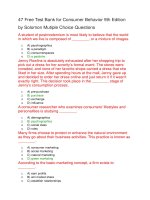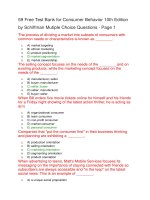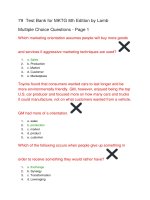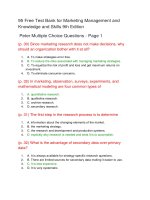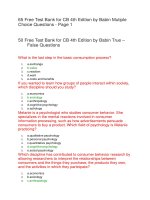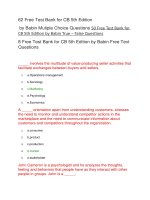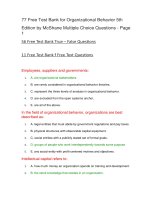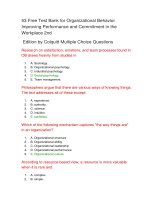79 free test bank for organizational behavior an evidence based approach 12th edition
Bạn đang xem bản rút gọn của tài liệu. Xem và tải ngay bản đầy đủ của tài liệu tại đây (133.28 KB, 21 trang )
39 Free Test Bank for Organizational Behavior An
Evidence Based Approach 12th Edition
by Luthans Multiple Choice Questions
25 Free Test Bank for True – False Questions
15 Free Test Bank for Free Text Questions
39 Free Test Bank for Organizational Behavior An
Evidence Based Approach 12th Edition by
Luthans Multiple Choice Questions
Pfeffer and Sutton identified five sources that prevented the
implementation and sustainability of the high
performance work practices. Identify which is NOT one
of the sources.
1.
2.
3.
4.
A. Debilitating fear
B. Destructive internal competition
C. Mindless reliance on precedent
D. Poorly designed and complex hierarchy
Which of the following is NOT a true statement about
behavioristic framework?
1.
A. Ivan Pavlov and John B. Watson used classical conditioning experiments to
formulate the stimulus-response (S-R) explanation of human behavior.
2. B. Ivan Pavlov and John B. Watson concentrated mainly on the impact of the
stimulus and felt that learning occurred when the R-S connection was made.
3. C. Skinner believed that the consequences of a response could better explain
most behaviors than eliciting stimuli could.
4. D. For Skinner, behavior is a function of its contingent environmental
consequences.
Organizational behavior researchers strive to attain all of the
following hallmarks of any science EXCEPT:
1.
2.
3.
4.
A. prediction.
B. understanding/explanation.
C. control.
D. diversification.
Which of the following is NOT an important environmental or
contextual dimension for organizational behavior?
1.
2.
3.
4.
A. Leadership
B. Globalization
C. Ethics
D. Diversity
James Brian Quinn believes that the organization of
enterprise and effective strategies will depend more on
development and deployment of _____ resources than
on the management of _____ assets.
1.
2.
3.
4.
A. intellectual; physical
B. human; monetary
C. technological; physical
D. natural; monetary
The relay room studies phase of the Hawthorne studies
concluded that:
1.
2.
3.
4.
A. the productivity would increase if the length of workday was reduced.
B. productivity was directly proportional to rest breaks.
C. productivity was independent to the method of payment.
D. the independent variables by themselves were not causing the change in the
dependent variable.
Travis is a new recruit in an advertising firm. During his first
week of work, he plans his actions, anticipates the
consequences, and determines the level of desired
performance. According to Bandura's Social Cognitive
Theory, which human capability is Travis
concentrating on?
1.
2.
3.
4.
A. Forethought
B. Symbolizing
C. Self-regulatory
D. Self-reflective
InvestorPro, an investment consulting firm plans to flatten
its traditional hierarchy structure. The intent is to
eliminate authoritarian positions in its structure and
create new ones that are operationally logical. The top
management agrees that none of the employees would
be laid-off but only transferred from their positions to
the new ones. This plan, when announced to its
employees, is not taken well by lower- and middlelevel management who did not want the structure to be
changed. When asked for a
1.
2.
3.
4.
A. Hawthorne effect
B. Paradigm effect
C. Audience effect
D. External validity
Ken is hired as a branch manager of a marketing firm only
because of his networks with important personalities
and his connections with potential clients. Which of
the following can he best provide to the organization?
1.
2.
3.
4.
A. Physical capital
B. Relation capital
C. Social capital
D. Positive psychological capital
If practitioners take on a more "Practitioner-Scientific" role
and academicians assume a more "ScientificPractitioner" role, it would result in a movement
towards:
1.
2.
3.
4.
A. evidence-based management.
B. relation management.
C. social facilitation.
D. positive psychological capital.
Which among the following does NOT signify the term
"paradigm?"
1.
2.
3.
4.
A. A framework
B. A way of thinking
C. A scheme for understanding technology
D. A scheme for understanding reality
Which among the following aspect of behavioral
management was not emphasized by early pioneers of
practicing management, such as Alfred P. Sloan?
1.
2.
3.
4.
A. Hierarchical structure
B. Specialization
C. Management functions of planning and controlling
D. Human dimension
Applied to the field of organizational behavior, a cognitive
approach has traditionally dominated all of the
following units of analysis EXCEPT:
1.
2.
3.
4.
A. personality and attitudes.
B. motivation.
C. goal setting.
D. research analysis.
Which of the following best explains positive psychological
capital?
1.
2.
3.
4.
A. What you know
B. Who you know
C. What you say
D. Who you can become
Which of the following involves the manipulation of
independent variables to measure their effect on, or
the change in, dependent variables, while everything
else is held constant or controlled?
1.
2.
3.
4.
A. The survey
B. The case
C. The experiment
D. The questionnaire
Which one of the following changes CANNOT be attributed
to the dynamic, technologically advanced work
environment?
1.
2.
3.
4.
A. A change in work ethics
B. A change in the traditional employment contract
C. A change in the nature of the work
D. A change in the composition of the workforce
Which of the following is NOT among the three most often
used designs in organizational behavior research
today?
1.
2.
3.
4.
A. The questionnaire
B. The case
C. The survey
D. The experiment
Increased productivity under controlled conditions can be
attributed solely to the fact that the participants in the
study are given special attention and that they are
enjoying a novel, interesting experience. This can be
referred to as:
1.
2.
3.
4.
A. social facilitation.
B. the paradigm effect.
C. groupthink.
D. the Hawthorne effect.
Which of the following tends to be more theoretically
oriented and at the macro level of analysis?
1.
2.
3.
4.
A. Organizational behavior
B. Organization theory
C. Organization development
D. Human resource management
Which of the following tends to be more theoretically
oriented and at the micro level of analysis?
1.
2.
3.
4.
A. Organizational behavior
B. Organization theory
C. Organization development
D. Human resource management
Peter is a new marketing research executive in a reputed
marketing firm. During the first week of his work, he
finds out about the performance of his peers and
supervisor and what they receive for it. According to
Bandura's Social Cognitive Theory, which human
capability is Peter concentrating on?
1.
2.
3.
4.
A. Forethought
B. Observational
C. Symbolizing
D. Self-reflective
The cognitive approach uses concepts all of the following
concepts EXCEPT:
1.
2.
3.
4.
A. expectancy.
B. attitude.
C. demand.
D. intention.
According to social learning, behavior can best be explained
in terms of a continuous reciprocal interaction among
all of the following determinants EXCEPT:
1.
2.
3.
4.
A. cognitive.
B. behavioral.
C. motivational.
D. environmental.
_____ is based on the idea, "An average of two contradicting
management study results is probably the best
estimate of how well or not that management
technique works."
1.
2.
3.
4.
A. Experimental design
B. Meta-analysis
C. Controlling factors
D. Law of averages
Which of the following tends to be more application oriented
and at the micro level of analysis?
1.
2.
3.
4.
A. Organizational behavior
B. Organization theory
C. Organization development
D. Human resource management
Which one of the following variables is NOT responsible for
separating the old human relations movement and the
evidence-based approach to the field of organizational
behavior?
1.
2.
3.
4.
A. Experimental design
B. Nature of employment
C. Group dynamics
D. Styles of leadership and supervision
_____ go hand in hand in evidence-based management.
1.
2.
A. Theory and research
B. Theory and meta-analysis
3.
4.
C. Assumption and facts
D. Meta-analysis and research
The reason for the existence of the many theories in the field
of organizational behavior is due to the _____ of the
variables involved.
1.
2.
3.
4.
A. objectivity and multidimensionality
B. variance and complexity
C. logicality and unidirectional behavior
D. complexity and multidimensionality
The cognitive part of the SCT recognizes the influential
contribution of thought processes to all of the
following EXCEPT human:
1.
2.
3.
4.
A. motivation.
B. attitudes.
C. action.
D. perceptions.
A manager following which of the following theories would
be of the opinion that employees are only interested in
money?
1.
2.
3.
4.
A. Social assumptions theory.
B. Theory X.
C. Theory Y.
D. Theory Z.
The _____ employed are/is the key to the successful use of
the experimental design.
1.
2.
3.
4.
A. variables
B. controls
C. creativity
D. personnel
Human resource of an organization includes all of the
following EXCEPT:
1.
2.
3.
4.
A. human capital.
B. social capital.
C. positive psychological capital.
D. relations capital.
Bill is a trainee executive in an accounting firm. He knows
that in order to do well in his career, he needs to
perform well. He has set internal standards for himself
so that he can evaluate the discrepancy between the
standard and the performance in order to improve it.
1.
2.
3.
4.
A. Forethought
B. Symbolizing
C. Self-regulatory
D. Self-reflective
Identify a method that was NOT used by traditional managers
to solve management problems and ensure maximum
productivity in the past.
1.
2.
3.
4.
A. Devise monetary incentive plans
B. Ensure job security
C. Provide regular paid leave
D. Provide good working conditions
Among the following, identify which is NOT part of high
performance work practices?
1.
2.
3.
4.
A. Job security
B. Self-managed teams
C. Pay for performance
D. Multi-source feedback system
Identify Jeff Pfeffer's "3 Its," correlating it to organizational
behavior theory and research.
1.
2.
3.
4.
A. Believe it.
B. Spread it.
C. Do it.
D. Stick with it.
David was recently promoted as the chief marketing officer
for Izet Pvt. Ltd. David was chosen because of his
remarkable marketing skills and his experience as
Vice-President for 15 years in a reputed marketing
firm. Which of the following can be attributed as a
reason for his promotion?
1.
2.
3.
4.
A. Physical capital
B. Human capital
C. Social capital
D. Positive psychological capital
Which of the following tends to be more application oriented
and at the macro level of analysis?
1.
2.
3.
4.
A. Organizational behavior
B. Organization theory
C. Organization development
D. Human resource management
Ruth has recently completed her first project as a project
manager. She analyses her project to understand how
well it went, to perceptually determine how well she
can handle projects in the future. According to
Bandura's Social Cognitive Theory, which human
capability is Ruth concentrating on?
1.
2.
3.
4.
A. Forethought
B. Symbolizing
C. Self-regulatory
D. Self-reflective
25 Free Test Bank for Organizational Behavior An
Evidence Based Approach 12th Edition by
Luthans True - False Questions
The behavioristic approach posits that cognitive processes
such as thinking, expectancies, and perception exist
and are essential to predict and control or manage
behavior.
1.
2.
True
False
Most of the practicing managers and their organizations
cultures believe, fully implement, and consistently
adhere to a full-fledged HPWPs approach to
management.
1.
2.
True
False
Personality characteristics such as conscientiousness can
serve as an example for organizational participants.
1.
2.
True
False
According to meta-analysis, if one study shows that a
management technique doesn't work and another
study shows that it does, an average of those results
is the best estimate of how well that management
practice works (or doesn't work).
1.
2.
True
False
The movement to not only recognize, but also do something
about the "Knowing-Doing Gap" is the movement
towards evidence-based management.
1.
2.
True
False
Laboratory studies tend to have better external validity than
field studies.
1.
2.
True
False
The problems with human organizations and the solutions
over the ages have undergone drastic changes
compared to their emphasis and surrounding
environmental context.
1.
2.
True
False
A paradigm establishes only written rules.
1.
2.
True
False
The major challenge and critical competitive advantage for
any organization is the human resource of that
company.
1.
2.
True
False
Roger, a sales manager for Heust Pvt. Ltd., is impressed with
his new sales executive, Tim. According to Roger, Tim
is optimistic, can perform well under pressure, and is
very confident about what he does. These qualities can
be referred to as "positive psychological capital."
1.
2.
True
False
Most of the "new management practices" are essentially a
readapted version of existing "old management
truths."
1.
2.
True
False
The social cognitive process can be a unifying theoretical
framework for both cognition and behaviorism.
1.
2.
True
False
According to Theory X, if employees were kept happy, they
would become high performers.
1.
2.
True
False
Reasons for considerable resistance to change and difficulty
to move from the old management paradigm to the
new can be explained by the "paradigm effect."
1.
2.
True
False
The experimental design of research used in organizational
behavior is largely borrowed from sociology.
1.
2.
True
False
Theory X is the natural choice for most organizations in
today's environment.
1.
2.
True
False
‘Paradigm shift' refers to the situation in which those in the
existing paradigm may not even see the changes that
are occurring, and therefore, cannot analyze the
changes.
1.
2.
True
False
The behavioristic approach has been labeled as being
mentalistic, while the cognitive approach has been
labeled deterministic.
1.
2.
True
False
The primary aim of any research design, establishing a
cause-and-effect relationship, is accomplished
through the experimental design.
1.
2.
True
False
The fact that today's managers are competent in their
functional specialization is sufficient to reiterate that
most of them paid close attention to the conceptual
and human dimensions of their jobs.
1.
2.
True
False
According to Edward Tolman, behavior is reactive, and is
directed towards situations.
1.
2.
True
False
The Hawthorne studies were more a result of planned study
than a serendipitous discovery.
1.
2.
True
False
The Hawthorne effect postulates that the increase in
productivity can be attributed to the special attention
received by the participants.
1.
2.
True
False
Casey, a relationship manager in a bank creates value for her
organization through her networks, connections, and
friends. These values can be referred to as "positive
psychological capital."
1.
2.
True
False
Behavioral science is almost as old as the physical and
biological sciences.
1.
2.
True
False
15 Free Test Bank for Organizational Behavior An
Evidence Based Approach 12th Edition by
Luthans Free Text Questions
Define organizational behavior.
Answer Given
Organizational behavior can be defined as the understanding, prediction, and
management of human behavior in organizations.
Define paradigm. What are the recent causes for a paradigm
shift? What are its consequences?
Answer Given
The term paradigm is used to mean a broad model, a framework, a way of
thinking, or a scheme for understanding reality. According to Joel Barker, a
paradigm establishes the rules (written or unwritten), defines the boundaries, and
tells one how to behave within the boundaries to be successful.
Discuss the importance given to employees in organizations
over time.
Answer Given
At first employees were considered a cost, then human resources, and now are
becoming widely recognized as "human capital" (what they know—education,
experience, skills). Even going beyond human capital are the more recently
recognized "social capital" (who they know—networks, connections, friends) and
"positive psychological capital" (who they are—confidence, hope, optimism,
resiliency) and (who they can become—one's possible, authentic self).
Summarize the relationship of organizational behavior to
other closely related disciplines.
Answer Given
Figure 1.2 explains the relationship of organizational behavior to other closely
related disciplines, which include organization theory (OT), organization
development (OD), and human resource management (HRM). Organization theory
tends to be more theoretically oriented and at the macro level of analysis.
Organizational behavior tends to be more theoretically oriented and at the micro
level of analysis. Organization development tends to be more application oriented
and at the macro level of analysis. Human resource management tends to be
more application oriented and at the micro level of analysis.
Describe the basic human capabilities according to
Bandura's Social Cognitive Theory.
Answer Given
Figure 1.4 summarizes the five basic human capabilities, which include: 1)
Symbolizing: It is the process by which employees process visual experiences into
cognitive models that then serve as guides for future actions; 2) Forethought: It is
the process in which employees plan their actions, anticipate the consequences,
and determine the level of desired performance; 3) Observational: It is the process
in which employees learn by observing the performance of referent (peers or
supervisors) and credible others (high performers), and the consequences they
receive for their actions; 4) Self-regulatory: It is the process in which employees
self-control their actions by setting internal standards and by evaluating the
discrepancy between the standard and the performance in order to improve it; 5)
Self-reflective: It is the process in which employees reflect back on their actions
and perceptually determine how strongly they believe they can successfully
accomplish the task in the future given the context (0 - 100% certainty).
(Discuss the differences in opinions of "Ivan Pavlov and
John B. Watson" and "B. F. Skinner."
Answer Given
Ivan Pavlov and John B. Watson stressed the importance of dealing with
observable behaviors instead of the elusive mind that had preoccupied earlier
psychologists. They used classical conditioning experiments to formulate the
stimulus-response (S-R) explanation of human behavior. Both Pavlov and Watson
felt that behavior could be best understood in terms of S-R. A stimulus elicits a
response. They concentrated mainly on the impact of the stimulus and felt that
learning occurred when the S-R connection was made. Skinner felt that the early
behaviorists helped explain respondent behaviors (those behaviors elicited by
stimuli) but not the more complex operant behaviors. Skinner found through his
operant conditioning experiments that the consequences of a response could
better explain most behaviors than eliciting stimuli could. He emphasized the
importance of the response-stimulus (R-S) relationship. The organism has to
operate on the environment in order to receive the desirable consequence. The
preceding stimulus does not cause the behavior in operant conditioning; it serves
as a cue to emit the behavior. For Skinner, behavior is a function of its contingent
environmental consequences.
Explain the purpose of evidence-based management.
Answer Given
The purpose of evidence-based management is to build a bridge to help close the
theory/research-practice gap from both sides, practice and academic. Traditionally,
practitioners have neither had the time nor the desire to read and translate
rigorous academic research and academics have not had the time, desire, nor
talent to write (translate the research) for practitioners. Practitioners must take on
more of a "Practitioner-Scientist" role and academics must assume a more
"Scientist-Practitioner" role. This movement to not only recognize, but also do
something about the "Knowing-Doing Gap" is the recently emerging movement
toward evidence-based management (EBM).
Explain the cognitive approach to organizational behavior.
How is it helpful?
Answer Given
The cognitive approach to human behavior has many sources of input. The
cognitive approach gives people much more "credit" than the other approaches.
The cognitive approach emphasizes the positive and freewill aspects of human
behavior and uses concepts such as expectancy, demand, and intention.
Cognition, which is the basic unit of the cognitive framework, can be simply
defined as the act of knowing an item of information. Under this framework,
cognitions precede behavior and constitute input into the person's thinking,
perception, problem solving, and information processing. Concepts such as
cognitive maps can be used as pictures or visual aids in comprehending a
person's "understanding of particular, and selective, elements of the thoughts
(rather than thinking) of an individual, group or organization."
What is the manager's perception of employees according to
Theory X? Does this approach still work? Why? What
is the assumption of the new perspective?
Answer Given
According to Theory X, managers think that their employees are basically lazy,
that they are interested only in money, and that if you can make them happy, they
would be high performers. This approach no longer works. The major fault with the
traditional approach is that it overlooks and oversimplifies far too many aspects of
the problem. Human behavior at work is much more complicated and diverse than
is suggested by the economic-security-working-conditions approach. Although
good pay, job security, and working conditions are necessary, it is now evident that
such a simplistic approach falls far short of providing a meaningful solution to the
complex challenges. The new perspective assumes that employees are extremely
complex and that there is a need for theoretical understanding backed by rigorous
empirical research before applications can be made for managing people
effectively.
Explain experimental design used in organizational behavior
research today.
Answer Given
The experimental design is borrowed largely from psychology, where it is used
extensively. A primary aim of any research design is to establish a cause-andeffect relationship. The experimental design offers the best possibility of
accomplishing this goal. All other factors being equal, most organizational
behavior researchers prefer this method of testing hypotheses. An experiment
involves the manipulation of independent variables to measure their effect on, or
the change in, dependent variables, while everything else is held constant or
controlled.
When does a study have external validity?
Answer Given
A study has external validity when the results are applicable to a wide range of
people and situations. External validity is concerned with the generalizability of the
results obtained.
When does a study have internal validity? What are its
threats? How can they be overcome?
Answer Given
A study has internal validity if there are no plausible alternative explanations of the
reported results other than those reported. The threats to internal validity include
uncontrolled intervening events that occur between the time the preexperiment
measurement is taken and the time the postexperiment measurement is taken.
The threats to internal validity can be overcome with careful design of the study.
Identify the basis of meta-analysis.
Answer Given
Meta-analysis is based on the idea that if one study shows that a management
technique doesn't work and another study shows that it does, an average of those
results is probably the best estimate of how well that management practice works
(or doesn't work).
List the sources that seem to prevent the majority of
managers from effective implementation and
sustainability?
Answer Given
1) Hollow talk; 2) Debilitating fear; 3) Destructive internal competition; 4) Poorly
designed and complex measurement systems; 5) Mindless reliance on precedent
What is paradigm effect? What are its consequences?
Answer Given
Paradigm effect is a situation in which those in the existing paradigm do not even
see the changes that are occurring, let alone reason and draw logical inferences
and perceptions about the changes. This results in considerable resistance to
change and difficulty to move from the old management paradigm to the new.

